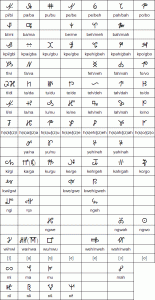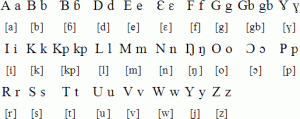Kpelle
Kpelle- History and Brief Intro. Lesson on Syllabary and Alphabet
One of the challenges of Kpelle (especially reading it) is the fact that Kpelle historically used a syllabary writing systems, which was very different from the typical latin alphabet. The syllabary was created in the 1930’s and was mainly used by chiefs. Kpelle syllabary isn’t really used anymore, diminishing during the 1980’s and 1990’s due to the promotion of English in schools and the two civil wars.
Kpelle Syllabary

Today Kpelle uses a version of the latin alphabet (see below), which in itself takes some time and effort to truly learn and understand. In fact, you need a specific keyboard or code to accurately write the language. Given that, most Kpelle speakers cannot read the language, something I found surprising when searching for Kpelle books in Liberia. I remember actually going to publishing companies and finding that not only are books in Kpelle very difficult to find and buy, but that those books that are around aren’t understood by most Kpelle speakers, including some of the language tutors of the language. This has proved a bit challenging at times and is partly the result of education policy that has attempted to remove indigenous language from the curriculum (particulary in the 1970’s), instead promoting English and Liberia’s ties to America. In fact, the 1970’s and thereafter saw teachers and school administrators forbid the speaking of indigenous languages on school grounds and promoted students taking on “English” and “Christian” names (correspondence with LIBTRALO). This is particularly interesting, given that the few remaining Kpelle resources were and are mainly created by Christian missionary organizations, to convert Liberians to Christianity and English. Kpelle is still spoken in several areas of Liberia and local NGO’s are attempting to bring it back into schools through indigenous language programs. Such indigenous language policy/curriculum have been supported in several surrounding African countries. USAID also promised to support the program a few years back, but support was reworked following Ebola, with money apparently shifting to the promotion of international-private providers (which is what I study. These schools also continue to undermine indigenous language, while promoting a one-size fits all educational model). As a result, Kpelle continues to not be taught in schools and is considered a dying language within many circles/communities in Liberia.
Given this somewhat sad (colonial/imperialist) history (and present), documenting the language is extremely important. But in order to learn and document the language it is essential that one understands the alphabet and its pronunciation. Below is a brief guide, starting with just consonants and some basics on sounds/pronunciation.
Consonants pronounced similar to that in English: b, d, f, h, k, l, n, m, p, s, w, v, z
G is always “hard” such as “garden” and never as in “general”
Kp and Gb are labiovelar sounds (sound made with the lips, ex. W) and have a soft sound (this is something that is very nuanced and difficult for most newcomers to the language. Both sounds are also extremely common in Kpelle and in traveling around Liberia, for example the capital of Bong county is Gbarnga, while the word Kpelle itself is pronounced this way).
Ny is similar to the sound in “canon”
L, r, and one of the two d sounds are interchangeable (and depends on the dialect and location within the word itself).
It is essential to keep in mind is that there are also three tones and pitch levels, which severely complicates learning the language.
Latin Alphabet


